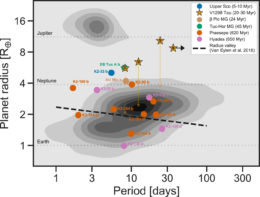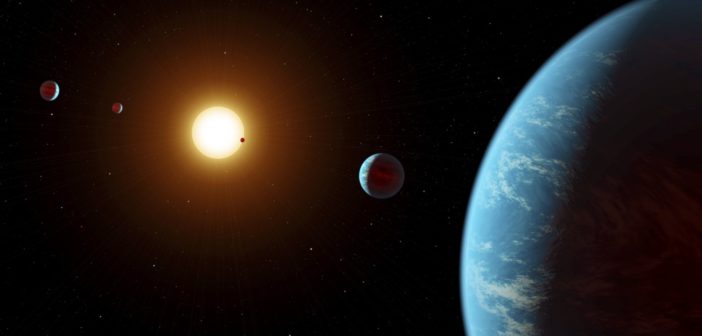Though we’ve discovered thousands of planets beyond our solar system, we still have a lot to learn about how these bodies form and evolve. Now, a newly discovered baby planetary system may provide some insight.
Multiplanet Wealth

An illustration of some of the planetary systems discovered by the Kepler spacecraft. The stars at the centers of these systems are not pictured. [NASA Ames/UC Santa Cruz]
Kepler multiplanet systems tend to be coplanar, with nearly circular orbits and low obliquities. There is often a high degree of intrasystem uniformity — planets of similar sizes, masses, and orbital spacing are more likely to be found together in the same system. And, intriguingly, most Kepler compact multiplanet systems tend to consist of small planets that have radii of less than 3 Earth radii.
Could these systems’ traits point to how they form and evolve? Might these planets once have had larger sizes, before they cooled and contracted or lost some of their atmospheres to photoevaporation? In order to answer these questions, we need to explore multiplanet systems much earlier in their lifetimes.

Phase-folded transits for each of the four V1298 Tau planet candidates. [Adapted from David et al. 2019]
New Baby Planets Found
Now, a team of scientists led by Trevor David (Jet Propulsion Laboratory, California Institute of Technology) has identified a system of planets that might be exactly what we’re looking for.
David and collaborators re-analyzed Kepler data from 2015 to identify three new planets transiting the young solar analog V1298 Tau, which was already known to host one Jupiter-sized planet on a 24 day orbit. The newly discovered planets have periods of 8.25 days, 12.46 days, and somewhere between 36 and 223 days (we only have one transit for this last one, so its orbit isn’t yet well-constrained).
Critically, V1298 Tau is a very young star, at just 23 million years old — so we’re examining this planetary system early in its formation.
A Valuable Laboratory

Young transiting exoplanets in the period–radius plane. The new planets discovered around V1298 Tau are indicated by yellow stars, and they occupy sparsely populated regions of the plane. Click to enlarge. [David et al. 2019]
The authors speculate that these planets may still be radiatively cooling and contracting, and perhaps losing atmosphere. The V1298 Tau system could, in fact, be the precursor to the compact multiplanet systems Kepler has found throughout the galaxy.
V1298 Tau provides a valuable laboratory to explore a stellar system in the early stages of its evolution. By following up with additional observations — such as planet mass measurements and atmospheric characterization — we stand to learn much more about how this baby planetary system and others like it formed and evolved.
Citation
“Four Newborn Planets Transiting the Young Solar Analog V1298 Tau,” Trevor J. David et al 2019 ApJL 885 L12. doi:10.3847/2041-8213/ab4c99
